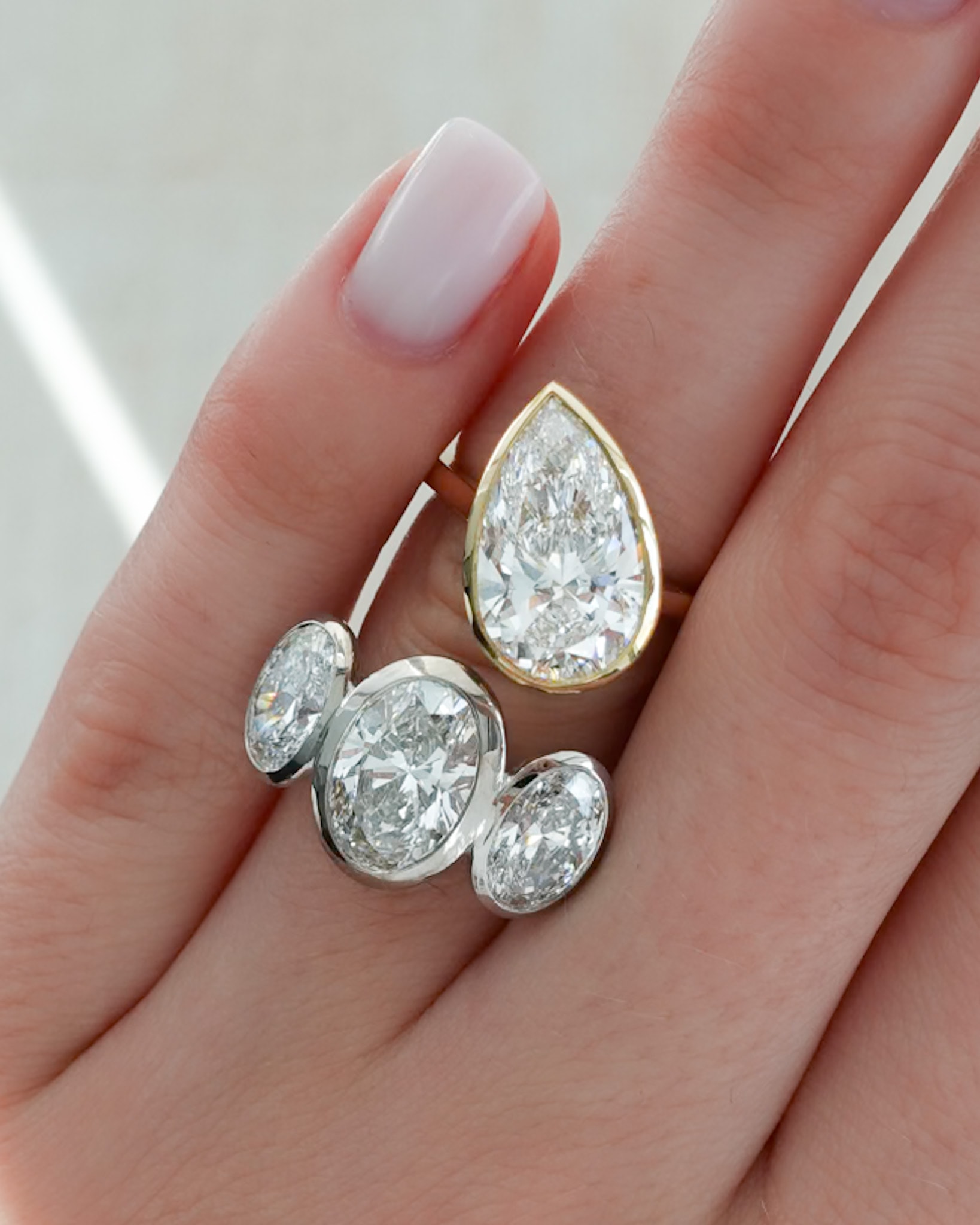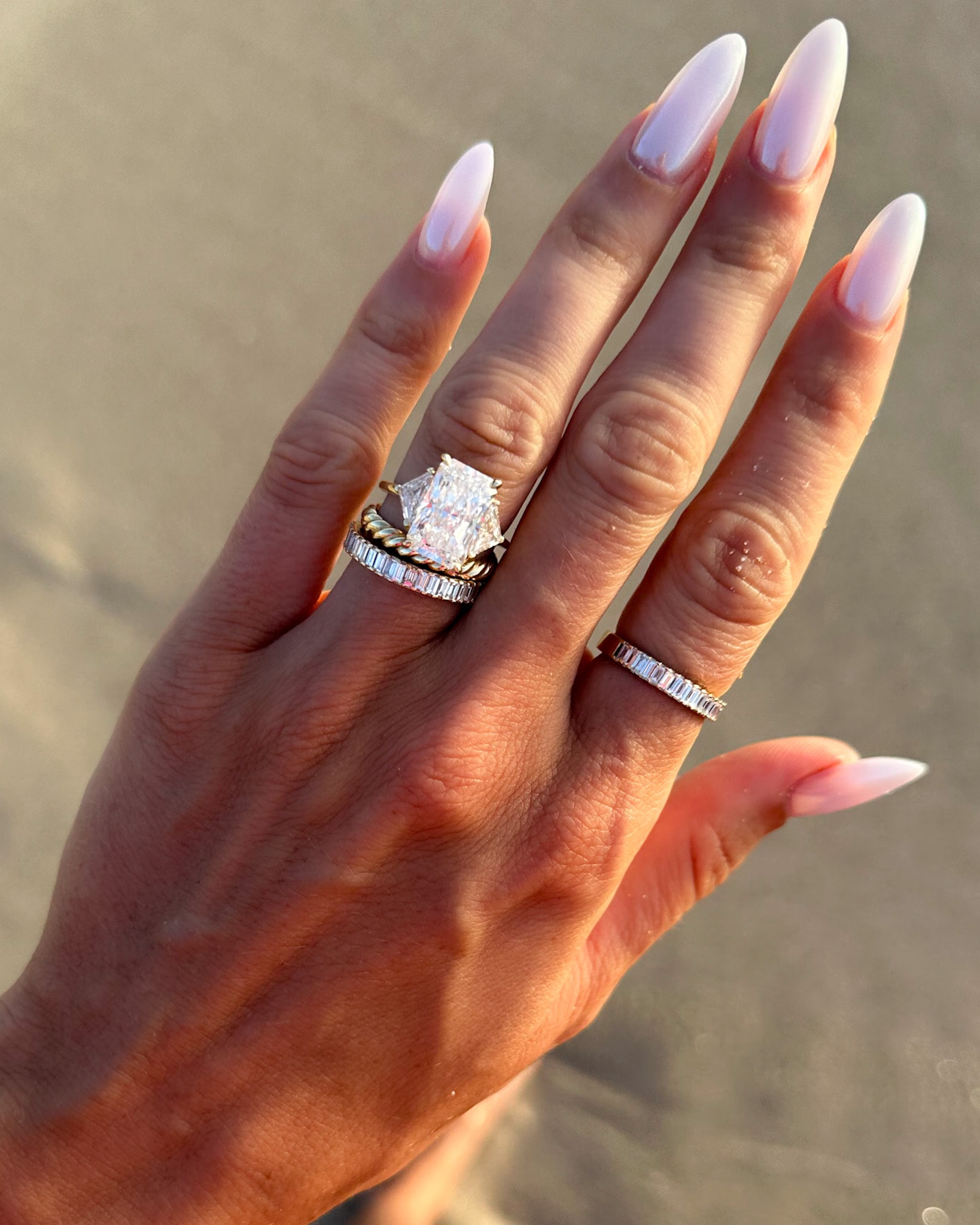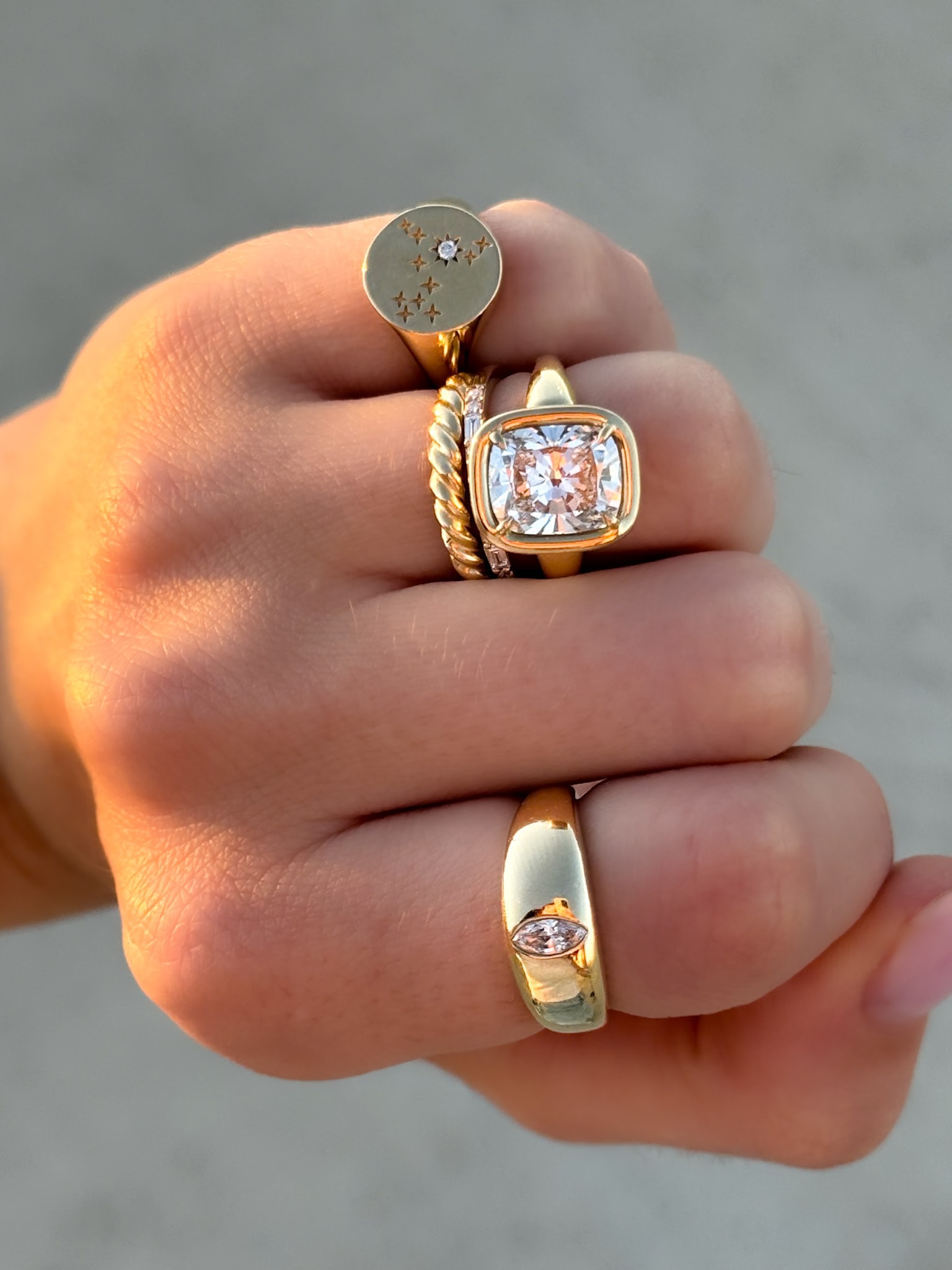Are Lab-Grown Diamonds Real Diamonds?
Diamonds—the mesmerizing gems that have captured modern lovebirds' hearts and adorned the crowns of kings and queens for centuries. Their brilliant sparkle seems to hold the secrets of the universe, not to mention wedded bliss. But beyond their dazzling appearance lies a world rich with history, science, and intrigue. Most interesting, of late, is the industry newbie lab grown diamonds.
Are they a fake diamond? Are they real? Are they worth all the buzz? In the battle between ancient mined diamonds vs lab created diamonds, there are plenty of people who will take sides. But each of these diamonds has its own unique value and appeal. If you're looking to buy lab grown diamonds for your engagement rings, or deciding that a mined diamond is the one, there's no right or wrong answer. But there is an informed answer. So let's dive in to get all the details on the dazzle.

Breaking the stigma surrounding lab-grown diamonds is a mission at GOODSTONE.
What is a Natural Diamond?
Natural diamonds are formed deep within the Earth, typically 90 to 120 miles beneath the surface, where conditions are up to 2,200 degrees Fahrenheit, and under immense pressure (around 725,000 pounds per square inch). This intense environment allows carbon atoms to crystallize over billions of years into the beautiful gems we know as diamonds. They are brought closer to the Earth's surface through volcanic eruptions. Diamonds mined by human hands and machinery are then cut and polished to fit our jewelry.

Pictured here, is a 2.12 ct Marquise Cut Mined diamond in our Finest Solitaire Setting.
What is a Lab Grown Diamond?
Lab-created diamonds are made with two primary methods: High Pressure-High Temperature (HPHT) and Chemical Vapor Deposition (CVD). In the HPHT method, a small seed crystal (often a natural diamond fragment) is placed in a carbon-rich environment and subjected to extreme pressure and temperature akin to natural diamond formation deep within the Earth. This process allows carbon atoms to crystallize around the seed, gradually forming a larger diamond over several weeks to months. Obviously much faster than the natural diamond process!
Alternatively, CVD involves placing a diamond seed in a chamber filled with a carbon-rich gas, typically methane. Through the application of high-energy microwave radiation or hot filament, the gas is ionized and carbon atoms are deposited layer by layer onto the diamond seed, gradually growing into a diamond crystal. This method can take several days to weeks to produce a finished diamond.

Buy now, get tomorrow with our Ready to Ship Diamond ring collection.
What About Simulants and Synthetics?
There's a chance you may hear terms like "synthetic diamond", "diamond simulant", or "artificial diamonds" thrown about when researching lab-created stones. So let's dissect those terms a bit.
Diamond Simulants
Simulants are materials that resemble diamonds in appearance but have different chemical compositions and physical properties. They are created to mimic the sparkle and brilliance of diamonds without being composed of carbon atoms like natural or lab-grown diamonds.
Throughout history, various materials have been used as diamond simulants, such as cubic zirconia (CZ), moissanite, and white sapphire. These materials gained popularity as affordable alternatives to diamonds for jewelry, often chosen for their optical properties that mimic the fire and brilliance of diamonds.
Synthetic Diamonds
Synthetic diamonds, also known as lab-grown or cultured diamonds (which is really what we are talking about here), are diamonds that are grown in a controlled environment rather than being mined from the Earth. They have the same chemical properties (pure carbon atoms arranged in a crystal lattice structure) and are physically and optically identical to natural diamonds.
The concept of synthetic diamonds dates back to the early 20th century when scientists successfully created diamonds using high-pressure, high-temperature (HPHT) processes. Later advancements in technology, such as Chemical Vapor Deposition (CVD), further refined the process, making it possible to produce larger, gem-quality diamonds. Today, synthetic diamonds are widely accepted within the jewelry industry and are graded and certified alongside natural diamonds by reputable gemological institutes like the Gemological Institute of America (GIA). More on this later.
Key Differences
-
Composition: Diamond simulants have different chemical compositions than diamonds, whereas synthetic diamonds have the same composition as natural diamonds.
-
Properties: Simulants mimic the optical properties of diamonds but may not have the same hardness or durability. Synthetic diamonds, on the other hand, possess identical hardness and durability to natural diamonds.
In summary, diamond simulants are materials that look like diamonds but are chemically different, while synthetic diamonds are genuine diamonds grown in a controlled laboratory environment, offering an ethical and sustainable alternative to mined diamonds.

Create an ethical and sustainable Penumbra Bezel Set Engagement ring with a lab grown diamond.
Differentiating Lab-Grown from Natural Diamonds
Given that lab diamonds are, in fact, diamonds, distinguishing between them and natural diamonds can be challenging without specialized equipment and expertise. Trained gemologists use spectroscopy and microscopy to examine diamonds for unique growth patterns, inclusions, and trace elements that may indicate their origin. Lab-grown diamonds often exhibit different growth structures and may lack certain natural inclusions found in diamonds formed over millions of years underground. However, advancements in lab-grown diamond technology have made it increasingly difficult to differentiate them visually from natural diamonds without expert analysis. What's most important to know is that with all the same properties, it's impossible for the average person to tell the difference between a lab grown diamond and their natural counterparts.

Travel the globe with a ring that will make jaws drop, like our, Three Stone Engagement Ring with Shield Side Stones and a Radiant cut Diamond.
Lab Grown Diamond Grading
The Gemological Institute of America (GIA) used to refer to lab grown diamonds as synthetic diamonds and not offer grading services on them. However, given the rise in popularity and understanding of lab diamonds as a real diamond, they now refer to lab-grown diamonds as "laboratory-grown" or "laboratory-created" diamonds rather than "synthetic."
This distinction is to emphasize that these diamonds are real diamonds, with the same chemical composition and crystal structure as natural diamonds, but produced in a controlled laboratory environment rather than formed naturally in the Earth's crust. This terminology helps avoid confusion and accurately reflects the nature of lab-grown diamonds as genuine gems.

Sparkle bright with our Split Shank Solitaire Engagement Ring with Marquise Cut Diamond.
Are Lab Grown Diamonds a Good Investment?
First of all, no diamond is a good financial investment, unless you're talking about a museum-worthy specimen. They are only a good investment in your love. But if you're asking about diamond pricing and value, that's a different story. All diamond pricing, natural or lab grown diamonds, is influenced by several factors, including their rarity, size, color, clarity, and cut. Market demand also influences their value. As awareness and acceptance of lab-grown diamonds grows amongst consumers and retailers, the pricing dynamics change.
In general, advances in technology, reduced production costs, and wider availability of lab-grown diamonds, has made them more accessible and affordable compared to their natural counterparts. They are typically cost less than natural diamonds, about half the cost of mined diamond of the same quality. But the value is really in perception. Certification from reputable gemological institutes along with ethical and environmental considerations by consumers have influenced the market position and pricing of lab created diamonds. It's really all about what's important to you: the rarity of a natural diamond, or the ethical sustainability of a lab diamond.

A GOODSTONE fan favorite, Club Ring Solitaire Engagement Ring With an 4 carat Elongated Cushion Cut Diamond.
Why Choose Lab-Grown?
Ok, so let's talk about the reasoning of why you might consider a lab grown diamond engagement ring for your own proposal:
-
Ethical Sparkle: No mining means less environmental impact and no ethical concerns about labor practices. Traditional diamond mining can have significant environmental consequences, including habitat destruction and water pollution. With lab-grown diamonds, you can shine bright knowing you’ve made a sustainable choice.
-
Budget-Friendly Bling: Let’s face it—diamonds can be pricey. Lab-grown diamonds often come with a more wallet-friendly price tag, making them accessible to shoppers. You can get the same sparkle without breaking the bank, leaving more room in your budget for other splurges.
-
Sparkle with a Story: Whether you're into cutting-edge technology or simply want to make a sustainable choice, lab-grown diamonds offer a modern twist on a timeless classic. Each lab-grown diamond has its own unique journey from lab to jewelry, adding a touch of innovation to your sparkle story.

Purchase multiple lab-grown diamond rings for the price of one natural engagement ring.
The Bottom Line
So, are lab-grown diamonds real diamonds? Absolutely! They may not have been formed under the Earth’s crust, but they’re chemically identical, ethically sound, and seriously stunning. These diamonds are created to bring you the same fire and brilliance of a natural one with the only difference being in how they are brought to life (and how much they hurt your bank account). Whether you’re popping the question or treating yourself to a bit of bling, lab-grown diamonds offer a sparkling choice that’s as brilliant as it is responsible.
No matter which diamond you choose for your engagement ring, our experts can help you understand the diamond market and shop for your dream ring all at once. Whether you shop from our collection or want to start the bespoke process to create a custom lab grown diamond engagement ring, we're here to help!








Leave a comment (all fields required)